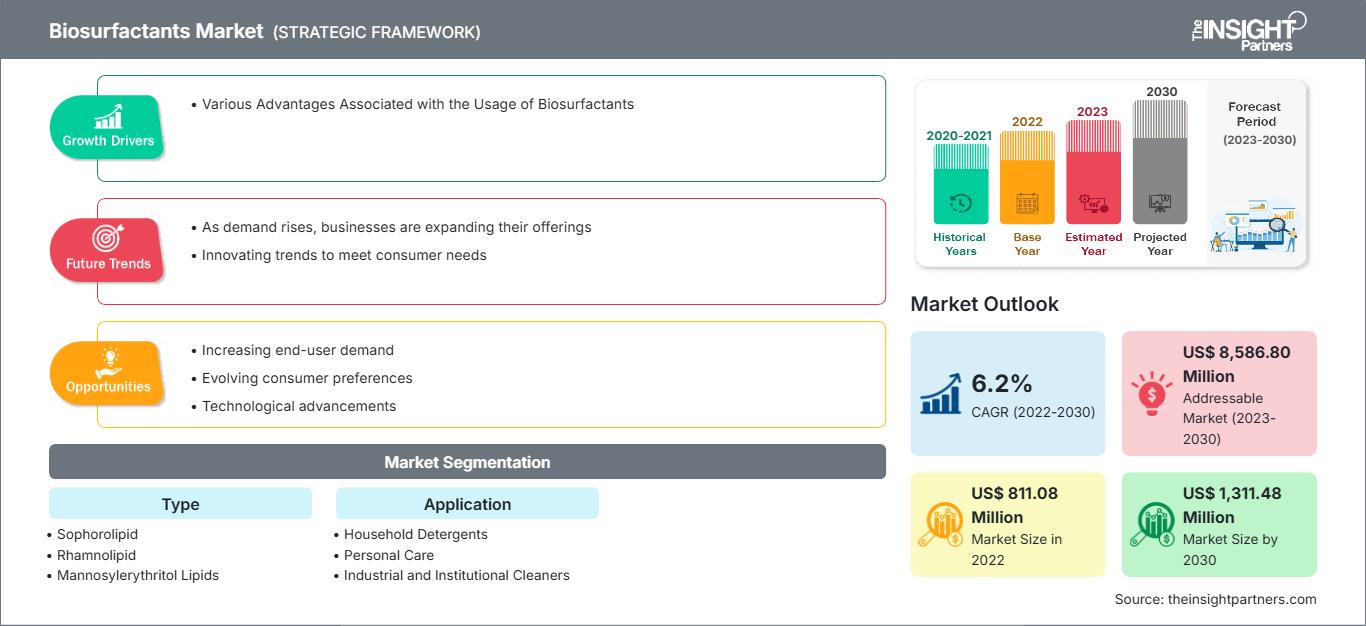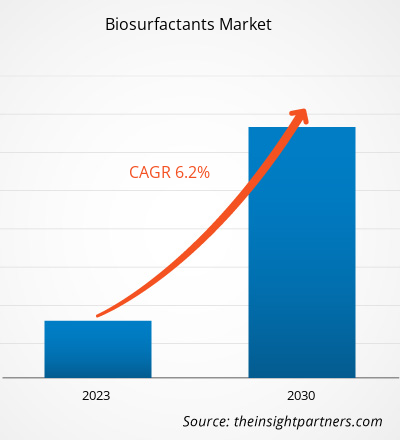[Forschungsbericht] Der Markt für Biotenside soll von 811,08 Millionen US-Dollar im Jahr 2022 auf 1.311,48 Millionen US-Dollar im Jahr 2030 wachsen; von 2022 bis 2030 wird ein durchschnittliches jährliches Wachstum von 6,2 % erwartet.
Markteinblicke und Analystenmeinung:
Biotenside sind oberflächenaktive Verbindungen, die mit einer ausgewählten Toxizität synthetisiert werden können. Neben biologischer Abbaubarkeit, geringer Toxizität und hohem Produktionspotenzial zeichnen sich Biotenside durch eine hohe Oberflächen- und Grenzflächenaktivität aus. Biotenside werden häufig in Agrarprodukten wie Pestiziden und anderen Chemikalien, in Reinigungsmitteln für den privaten, medizinischen und Gesundheitsbereich sowie in Körperpflege- und Kosmetikprodukten wie Shampoo, Haschischwaschmitteln, Seife und vielen weiteren Produkten verwendet. Aufgrund der steigenden Nachfrage nach Biotensiden aus vielen Endverbrauchsbranchen, darunter Öl und Energie, Landwirtschaft, Chemie, Pharmazie, Medizin und Gesundheitswesen, Konsumgüter und andere, boomt dieser Markt von Tag zu Tag. Dieser Faktor treibt den globalen Markt für Biotenside maßgeblich voran.
Wachstumstreiber und Herausforderungen:
Biotenside bieten gegenüber chemischen Tensiden mehrere Vorteile, wie z. B. hohe biologische Abbaubarkeit, Vielfalt biologischer Eigenschaften und erneuerbare Eigenschaften, da sie als Mischung verschiedener Moleküle synthetisiert werden. Biotenside haben verschiedene Eigenschaften, darunter antimikrobielle und antioxidative Aktivität, die ihre Anwendung in verschiedenen Branchen wie Waschmittel und Körperpflege ermöglichen. Sie sind außerdem hocheffizient bei der Reduzierung von Oberflächen- und Grenzflächenspannungen. Darüber hinaus sind steigender Lebensstandard, Bevölkerungswachstum, zunehmende Urbanisierung, die zunehmende Einführung innovativer Produkte und ein steigendes Verbraucherbewusstsein in Bezug auf Gesundheit und Hygiene Schlüsselfaktoren, die die Nachfrage nach Haushaltswaschmitteln und Reinigungsprodukten weltweit ankurbeln. Darüber hinaus steigern verschiedene Marketingaktivitäten und Kampagnen der Marktteilnehmer das Bewusstsein der Verbraucher für Waschmittel wie Gele, Pods und Flüssigkeiten. In den letzten Jahren ist der Markt für Reinigungsprodukte in China stetig gewachsen. Die Hersteller stehen jedoch vor der Herausforderung, eine wirtschaftlich rentable industrielle Produktion von Biotensiden zu erreichen. Die Herstellungskosten von Biotensiden sind aufgrund der geringeren Ausbeute im Vergleich zu kommerziellen synthetischen Tensiden hoch. Hohe Rohstoffkosten, aufwendige Reinigung und Weiterverarbeitung wirken sich auf die Produktionskosten aus. Der Hauptnachteil von Biotensiden ist ihr hoher Preis, der die Nachfrage nach Biotensiden erheblich senkt.
Passen Sie diesen Bericht Ihren Anforderungen an
Sie erhalten kostenlos Anpassungen an jedem Bericht, einschließlich Teilen dieses Berichts oder einer Analyse auf Länderebene, eines Excel-Datenpakets sowie tolle Angebote und Rabatte für Start-ups und Universitäten.
Markt für Biotenside: Strategische Einblicke

-
Holen Sie sich die wichtigsten Markttrends aus diesem Bericht.Dieses KOSTENLOSE Beispiel umfasst Datenanalysen, die von Markttrends bis hin zu Schätzungen und Prognosen reichen.
Berichtssegmentierung und -umfang:
Der globale Markt für Biotenside ist nach Typ, Anwendung und Geografie segmentiert. Nach Typ ist der Markt für Biotenside in Sophorolipid, Rhamnolipid, Mannosylerythritollipide (MELs), Alkylpolyglucoside (APGs), Surfactin, Phospholipide, Polymere und andere unterteilt. Nach Anwendung ist der Markt für Biotenside in Haushaltsreiniger, Körperpflege, industrielle und institutionelle Reiniger, Lebensmittelverarbeitung, Ölfeldchemikalien, Lederverarbeitung, Landwirtschaft, Pharmazeutika und andere unterteilt. Geografisch ist der Markt in Nordamerika (USA, Kanada und Mexiko), Europa (Deutschland, Frankreich, Großbritannien, Russland, Italien und übriges Europa), Asien-Pazifik (Südkorea, Australien, China, Japan, Indien und übriger Asien-Pazifik-Raum), den Nahen Osten und Afrika (VAE, Südafrika, Saudi-Arabien und Rest des Nahen Ostens und Afrikas) sowie Süd- und Mittelamerika (Brasilien, Argentinien und Rest von Süd- und Mittelamerika).
Segmentanalyse:
Basierend auf dem Typ ist der Markt für Biotenside in Sophorolipid, Rhamnolipid, Mannosylerythritollipide (MELs), Alkylpolyglucoside (APGs), Surfactin, Phospholipide, Polymere und andere unterteilt. Das Sophorolipid-Segment hatte 2022 den größten Marktanteil. Sophorolipide sind eine Klasse von Glykolipid-Biotensiden, die von Hefen, hauptsächlich Candida bombicola, produziert werden. Diese Moleküle besitzen hervorragende oberflächenaktive Eigenschaften, was sie für verschiedene Anwendungen wie Körperpflegeprodukte, Reinigungsmittel, Lebensmittelzusatzstoffe, Pharmazeutika und Umweltsanierung wertvoll macht. In der Kosmetik haben Sophorolipide als natürliche und biologisch abbaubare Emulgatoren und Schaumbildner an Bedeutung gewonnen. Ihre Fähigkeit, Formulierungen zu stabilisieren und gleichzeitig hautschonend zu sein, entspricht der zunehmenden Vorliebe der Verbraucher für umweltfreundliche und hautfreundliche Produkte. Je nach Anwendung ist der Markt für Biotenside in Haushaltsreiniger, Körperpflege, industrielle und institutionelle Reinigungsmittel, Lebensmittelverarbeitung, Ölfeldchemikalien, Lederverarbeitung, Landwirtschaft, Pharmazeutika und andere unterteilt. Der Marktanteil des Segments Haushaltsreiniger am Markt für Biotenside war im Jahr 2022 bemerkenswert. Biotenside haben sich bei der Reinigung harter Oberflächen und in Formulierungen für Geschirrspülmittel bewährt. Dies ist teilweise auf ihr geringes Schaumprofil und ihre Oberflächenaktivitätseigenschaften zurückzuführen, die für weitere Anwendungen potenziell interessant sind. Sie vereinen ein hervorragendes Umweltprofil mit ausgezeichneter Effizienz und eignen sich daher für den Einsatz in Haushaltswaren.
Regionale Analyse:
Der Markt für Biotenside ist in fünf Schlüsselregionen unterteilt: Nordamerika, Europa, Asien-Pazifik, Süd- und Mittelamerika sowie Naher Osten und Afrika. Europa dominierte den globalen Markt für Biotenside, und der regionale Markt machte im Jahr 2022 etwa 300 Millionen US-Dollar aus. Nordamerika leistet ebenfalls einen wichtigen Beitrag und hält einen erheblichen Anteil am globalen Marktanteil von Biotensiden. Der nordamerikanische Markt wird im Jahr 2030 voraussichtlich über 340 Millionen US-Dollar erreichen. Der Asien-Pazifik-Raum wird von 2022 bis 2030 voraussichtlich eine beträchtliche CAGR von über 7 % verzeichnen. Der Markt für Biotenside im Asien-Pazifik-Raum ist nach Ländern unterteilt in Australien, China, Indien, Japan, Südkorea und den Rest des Asien-Pazifik-Raums. Der Markt wird von Faktoren wie der wachsenden Nachfrage aus der Wasch- und Reinigungsmittelindustrie und dem zunehmenden Bewusstsein für die Vorteile von Biotensiden getrieben. Diese biokompatiblen und umweltfreundlichen Biotenside erfreuen sich aufgrund ihrer vielseitigen Anwendungsmöglichkeiten in Branchen wie Körperpflege, Pharmazie, Landwirtschaft und Ölförderung zunehmender Beliebtheit. Das steigende Bewusstsein für nachhaltige und umweltfreundliche Technologien dürfte die Nachfrage nach Biotensiden aufgrund ihrer Wirksamkeit bei der Reduzierung der Umweltbelastung ankurbeln. Darüber hinaus hat der zunehmende Fokus auf die Reduzierung der Abhängigkeit von traditionellen petrochemischen Tensiden Unternehmen im asiatisch-pazifischen Raum dazu veranlasst, in die Forschung, Entwicklung und Produktion dieser biobasierten Alternativen zu investieren.
Biotenside
Regionale Einblicke in den Markt für BiotensideDie Analysten von The Insight Partners haben die regionalen Trends und Faktoren, die den Markt für Biotenside im Prognosezeitraum beeinflussen, ausführlich erläutert. In diesem Abschnitt werden auch die Marktsegmente und die geografische Lage in Nordamerika, Europa, Asien-Pazifik, dem Nahen Osten und Afrika sowie Süd- und Mittelamerika erörtert.
Umfang des Marktberichts zu Biotensiden
| Berichtsattribut | Einzelheiten |
|---|---|
| Marktgröße in 2022 | US$ 811.08 Million |
| Marktgröße nach 2030 | US$ 1,311.48 Million |
| Globale CAGR (2022 - 2030) | 6.2% |
| Historische Daten | 2020-2021 |
| Prognosezeitraum | 2023-2030 |
| Abgedeckte Segmente |
By Typ
|
| Abgedeckte Regionen und Länder |
Nordamerika
|
| Marktführer und wichtige Unternehmensprofile |
|
Dichte der Marktteilnehmer für Biotenside: Verständnis ihrer Auswirkungen auf die Geschäftsdynamik
Der Markt für Biotenside wächst rasant. Die steigende Nachfrage der Endverbraucher ist auf Faktoren wie veränderte Verbraucherpräferenzen, technologische Fortschritte und ein stärkeres Bewusstsein für die Produktvorteile zurückzuführen. Mit der steigenden Nachfrage erweitern Unternehmen ihr Angebot, entwickeln Innovationen, um den Bedürfnissen der Verbraucher gerecht zu werden, und nutzen neue Trends, was das Marktwachstum weiter ankurbelt.

- Holen Sie sich die Markt für Biotenside Übersicht der wichtigsten Akteure
Branchenentwicklungen und zukünftige Chancen:
Nachfolgend sind verschiedene Initiativen der wichtigsten Akteure auf dem Markt für Biotenside aufgeführt:
- Im März 2023 gaben Holiferm Ltd und Sasol Chemicals, eine Geschäftseinheit von Sasol Ltd., eine Zusammenarbeit zur Herstellung und Vermarktung von Rhamnolipiden und Mannosylerythritollipiden (MELs) bekannt. Diese Zusammenarbeit erweitert die im März 2022 angekündigte Partnerschaft zwischen den beiden Unternehmen zur Entwicklung und Vermarktung eines weiteren Biotensidprodukts, Sophorolipide.
Auswirkungen von COVID-19:
Die COVID-19-Pandemie betraf verschiedene Branchen in mehreren Ländern. Lockdowns, Reisebeschränkungen und Geschäftsschließungen in Nordamerika, Europa, im asiatisch-pazifischen Raum (APAC), Süd- und Südamerika Mittelamerika (SAM) sowie der Nahe Osten und Afrika (MEA) bremsten das Wachstum mehrerer Branchen, darunter der Chemie- und Werkstoffindustrie. Die Schließung von Produktionseinheiten störte die globalen Lieferketten, Fertigungsaktivitäten, Lieferpläne sowie den Verkauf lebensnotwendiger und nicht lebensnotwendiger Produkte. Verschiedene Unternehmen meldeten Verzögerungen bei Produktlieferungen und einen Einbruch ihrer Produktverkäufe im Jahr 2020. Aufgrund der pandemiebedingten Wirtschaftsrezession wurden die Verbraucher bei Kaufentscheidungen vorsichtiger und wählerischer. Aufgrund niedrigerer Einkommen und unsicherer Verdienstaussichten schränkten die Verbraucher nicht lebensnotwendige Einkäufe erheblich ein, insbesondere in Entwicklungsregionen. Viele Hersteller von Biotensiden verzeichneten aufgrund der geringeren Verbrauchernachfrage in der Anfangsphase der Pandemie sinkende Gewinne. Bis Ende 2021 waren jedoch viele Länder vollständig geimpft und die Regierungen verschiedener Länder kündigten Lockerungen bestimmter Vorschriften an, darunter Ausgangssperren und Reiseverbote. Die Menschen begannen zu reisen, was die Nachfrage nach Biotensiden erhöhte. All diese Faktoren fördern das Wachstum des Marktes für Biotenside in verschiedenen Regionen.
Wettbewerbslandschaft und Schlüsselunternehmen:
Dow Inc., Allied Carbon Solutions Co. Ltd., Saraya Co. Ltd., Evonik Industries AG, BASF SE, Sabo SPA, Holiferm Ltd., Stepan Co., Deguan Biosurfactant Supplier und Jeneil Bioproducts GmbH gehören zu den führenden Akteuren auf dem globalen Markt für Biotenside. Diese Unternehmen bieten hochwertige Biotenside an und bedienen viele Verbraucher auf dem Weltmarkt.
- Historische Analyse (2 Jahre), Basisjahr, Prognose (7 Jahre) mit CAGR
- PEST- und SWOT-Analyse
- Marktgröße Wert/Volumen – Global, Regional, Land
- Branchen- und Wettbewerbslandschaft
- Excel-Datensatz
Aktuelle Berichte
Verwandte Berichte
Erfahrungsberichte
Grund zum Kauf
- Fundierte Entscheidungsfindung
- Marktdynamik verstehen
- Wettbewerbsanalyse
- Kundeneinblicke
- Marktprognosen
- Risikominimierung
- Strategische Planung
- Investitionsbegründung
- Identifizierung neuer Märkte
- Verbesserung von Marketingstrategien
- Steigerung der Betriebseffizienz
- Anpassung an regulatorische Trends






















 Kostenlose Probe anfordern für - Markt für Biotenside
Kostenlose Probe anfordern für - Markt für Biotenside